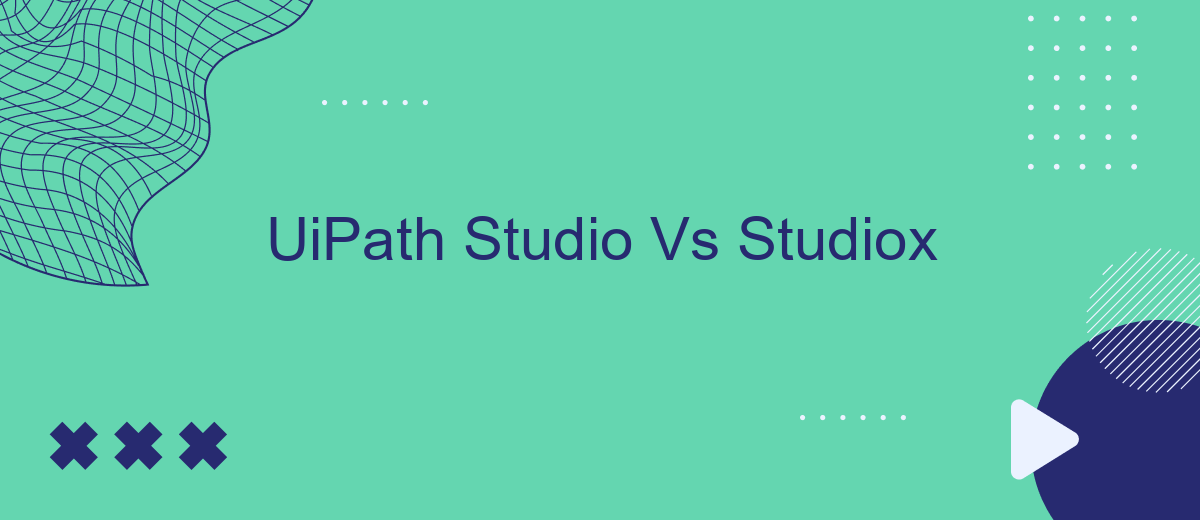When it comes to automating repetitive tasks, UiPath offers two powerful tools: Studio and StudioX. While both are designed to streamline workflows, they cater to different audiences and skill levels. Studio is geared towards developers with coding expertise, whereas StudioX is tailored for business users with no coding background. This article explores the key differences and benefits of each platform.
Overview
UiPath Studio and StudioX are powerful tools for robotic process automation (RPA), each designed to cater to different user needs and expertise levels. UiPath Studio is tailored for developers and advanced users who require a comprehensive set of features to create complex automation workflows. In contrast, StudioX is designed for business users with little to no programming experience, offering a more intuitive and simplified interface.
- UiPath Studio: Advanced features, suitable for developers, supports complex workflows.
- UiPath StudioX: User-friendly, designed for business users, easy to use with minimal training.
Both platforms integrate seamlessly with various services and tools to enhance automation capabilities. For instance, SaveMyLeads can be utilized to streamline lead management processes, automatically transferring data between different systems and reducing manual work. This integration capability makes both UiPath Studio and StudioX versatile choices for businesses aiming to optimize their operations through RPA.
Key Features

UiPath Studio and StudioX both offer robust features tailored to different user needs. UiPath Studio is designed for developers and advanced users, providing extensive capabilities for complex automation projects. It supports custom coding, advanced debugging, and a wide range of integrations, making it highly suitable for enterprise-level automation. StudioX, on the other hand, is aimed at business users with little to no coding experience. It simplifies the automation process through a user-friendly interface and drag-and-drop functionality, enabling users to automate everyday tasks effortlessly.
One of the standout features of both platforms is their ability to integrate with various services and applications. For instance, SaveMyLeads can be seamlessly integrated to automate lead management processes. This service allows users to connect UiPath automations with CRM systems, email marketing tools, and other platforms without needing extensive technical knowledge. By leveraging such integrations, businesses can streamline their workflows and enhance productivity, regardless of whether they are using UiPath Studio or StudioX.
Differences

UiPath Studio and StudioX are two distinct tools designed for different user bases and automation needs. While both are part of the UiPath ecosystem, they cater to varying levels of expertise and use cases.
- User Base: UiPath Studio is designed for developers and IT professionals, whereas StudioX targets business users with no coding experience.
- Complexity: Studio offers advanced features for complex automation tasks, while StudioX simplifies the process with a user-friendly interface.
- Integration Capabilities: Studio provides extensive integration options, including the ability to use services like SaveMyLeads for seamless data transfer between applications. StudioX, while capable, focuses on more straightforward integrations.
- Customization: UiPath Studio allows for deep customization and scripting, whereas StudioX uses pre-built templates and activities to streamline automation.
In summary, UiPath Studio is ideal for those who need robust and customizable automation solutions, while StudioX is perfect for business users looking to automate routine tasks without needing technical skills. Both tools complement each other within the UiPath ecosystem, ensuring a wide range of automation capabilities for different user needs.
Pricing

When comparing UiPath Studio and StudioX, pricing is a crucial factor to consider. Both platforms offer different pricing models tailored to various user needs, from individual developers to large enterprises. UiPath Studio is generally aimed at professional developers and larger organizations, whereas StudioX is designed for business users with less technical expertise.
UiPath Studio's pricing is more flexible, with options for annual or monthly subscriptions. It also provides a free Community Edition for small teams or individual developers. On the other hand, StudioX has a simpler pricing structure, making it more accessible for small businesses and non-technical users.
- UiPath Studio: Flexible pricing, including annual and monthly subscriptions.
- StudioX: Simplified pricing structure, ideal for small businesses.
- Free Community Edition available for UiPath Studio.
Both platforms also offer additional services and integrations to enhance their functionality. For example, SaveMyLeads can be used to automate lead management processes, integrating seamlessly with UiPath to streamline workflows and improve efficiency. This makes both UiPath Studio and StudioX versatile options for various automation needs.
Use Cases
UiPath Studio is primarily designed for developers and advanced users who need to create complex automation workflows. It is ideal for tasks such as data extraction, system integration, and process optimization. With its advanced debugging and error handling features, UiPath Studio is suitable for large-scale enterprise automation projects that require precision and customization. For instance, integrating multiple systems and applications seamlessly can be achieved through detailed scripting and API calls, making it a powerful tool for IT departments and professional developers.
UiPath StudioX, on the other hand, is tailored for business users with little to no coding experience. It simplifies the automation process with a user-friendly interface and drag-and-drop functionality. StudioX is perfect for automating repetitive tasks such as data entry, email management, and report generation. It empowers non-technical users to automate their daily workflows without relying on IT support. Additionally, services like SaveMyLeads can be integrated with StudioX to streamline lead management processes, allowing users to automate the transfer of data between various CRM systems and marketing platforms effortlessly.
- Automate the work with leads from the Facebook advertising account
- Empower with integrations and instant transfer of leads
- Don't spend money on developers or integrators
- Save time by automating routine tasks
FAQ
What is the primary difference between UiPath Studio and StudioX?
Can I use both UiPath Studio and StudioX in the same project?
Is it possible to integrate UiPath Studio and StudioX with other applications?
How do I decide whether to use UiPath Studio or StudioX for my project?
What kind of support and resources are available for learning UiPath Studio and StudioX?
Personalized responses to new clients from Facebook/Instagram. Receiving data on new orders in real time. Prompt delivery of information to all employees who are involved in lead processing. All this can be done automatically. With the SaveMyLeads service, you will be able to easily create integrations for Facebook Lead Ads and implement automation. Set up the integration once and let it do the chores every day.

